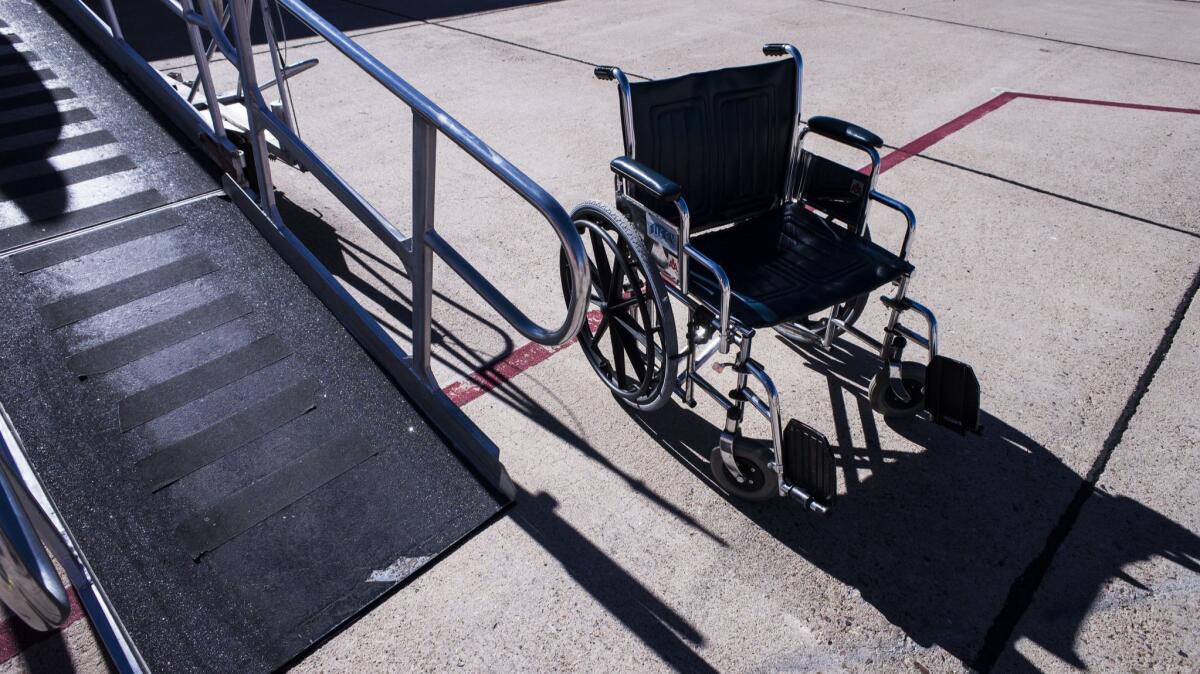Which airlines damage the most wheelchairs? New rules mean you can find out

- Share via
The first federally mandated reports are out showing how many mobility devices get damaged by airlines, and the data paint a disturbing picture.
Consumer reports show that the 12 largest airlines mishandled about 2% of all devices on planes in December and January.
Although the number of chairs calculated in the reports may seem insignificant, consider the effect: From Dec. 4-31, air carriers handled more than 32,000 devices — and lost or damaged 701 of them, according to the reports.
Put another way, during one of the most important travel months of the year, the wheelchairs or scooters of an average 26 people a day were broken or got lost.
“If you really understand what a wheelchair means to someone who uses it, it’s a huge number,’’ said Shaun Castle, deputy executive director for Paralyzed Veterans of America. “That means 26 people per day lose their ability to move.”
The damage reports are required after PVA’s lawsuit against the Department of Transportation, and subsequent congressional action in the FAA Reauthorization Act of 2018. The reports illuminate a systemic problem within the airline industry.
The wheelchair that Castle, a service-disabled Army veteran, uses has been bent, cracked and lost in separate air travel incidents.
“You broke my chair. It’s not usable anymore due to your negligence. It’s like you are literally breaking my legs,” he said. “If airlines were, through negligence, breaking legs and arms, imagine the news coverage.”
The early numbers aren’t complete.
Southwest, which reported damaging 4% of passengers’ mobility devices in January, and American, which reported damaging nearly 6%, told the government they did not accurately capture the data for all wheelchairs and scooters on aircraft.
The trouble cuts across all carriers and all classes of travelers.
Consider U.S. Sen. Tammy Duckworth (D-Ill.), a combat veteran and double amputee. Her wheelchair has been damaged several times during air travel, including the December reporting period. She was instrumental in getting the disclosure rule added as an amendment to the FAA reauthorization bill.
“Travelers should be able to find out if certain airlines have high rates of breaking wheelchairs and other equipment that people depend on, just like we can find out if certain airlines have high rates of flight delays or cancellations,” Duckworth said in a statement.
You can’t tell from just two months the full scope of the problem. Some carriers have gotten ahead of the bad news by promising to improve the way they stow wheelchairs and scooters. Disability rights groups and consumer advocates vow to hold them accountable.
For now, travelers should view the damage reports for themselves and decide which airlines to take a chance on.
The data are issued monthly but lag by a few months. You can see the January and February reports now at bit.ly/mobilitydevicereports; the numbers for mobility devices are on Page 36.
PVA breaks out the wheelchair data on its website (bit.ly/PVAmishandlestatistics).
PVA offers this advice for disabled fliers:
►Attach written instructions for folding and stowing directly to your wheelchair or scooter.
►Carry removable parts, such as seat cushions, side guards and wheels, on the plane with you.
►If you’re taking a manual wheelchair and flying on a wide-body aircraft such as an A-380 or a 777 (they tend to have more storage space), ask that your chair be stored in the on-board closet to minimize the chances of damage.
►When your equipment is returned to you, inspect it thoroughly before leaving the airport. If damage is present, report it immediately to the airline to start your claim and the maintenance process.
►Register your complaint with the federal government. This helps the DOT enforce the rules and hold airlines accountable. Once you file a complaint, the airline is required to respond to you and to the DOT.
You have three options for filing a complaint:
►Online: Air consumer complaint form (bit.ly/devicecomplaintform)
►By phone: (202) 366-2220 (TTY [202] 366-0511)
►By mail: Aviation Consumer Protection Division, C-75 U.S. Department of Transportation. 1200 New Jersey Ave. S.E., Washington, DC 20590
More to Read
Sign up for The Wild
We’ll help you find the best places to hike, bike and run, as well as the perfect silent spots for meditation and yoga.
You may occasionally receive promotional content from the Los Angeles Times.






